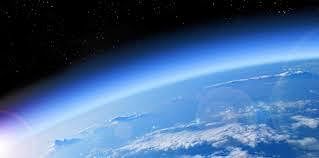NCERT Solutions for Class 7 Social Science - Air
Q1. Answer the following questions.
(i) What is atmosphere?
Ans: The earth is surrounded by a huge blanket of air called atmosphere.
 Atmosphere
Atmosphere
(ii) Which two gases make the bulk of the atmosphere?
Ans: Nitrogen and oxygen make the bulk of the atmosphere.
(iii) Which gas creates green house effect in the atmosphere?
Ans: Carbon dioxide creates the greenhouse effect in the atmosphere.
(iv) What is weather?
Ans: Weather is short-term state of the atmosphere whether it is hot or cold, wet or dry. It is the hour to hour, day to day condition of the atmosphere.
(v) Name three types of rainfall?
Ans: Three types of rainfall are:
(i) Convectional rainfall
(ii) Orographic rainfall
(iii) Cyclonic rainfall
(vi) What is air pressure?
Ans: The pressure exerted by the weight of air on the surface of the earth is called air pressure.
Q2. Tick the correct answer.
(i) Which of the following gases protects us from harmful sun rays?
(a) Carbon dioxide
(b) Nitrogen
(c) Ozone
Ans: (c)
(ii) The most important layer of the atmosphere is
(a) Troposphere
(b) Thermosphere
(c) Mesosphere
Ans: (a)
(iii) Which of the following layers of the atmosphere is free from clouds?
(a) Troposphere
(b) Stratosphere
(c) Mesosphere
Ans: (b)
(iv) As we go up the layers of the atmosphere, the pressure
(a) Increases
(b) Decreases
(c) Remains the same
Ans: (b)
(v) When precipitation comes down to the earth in the liquid form, it is called
(a) Cloud
(b) Rain
(c) Snow
An: (b)
Q3. Match the following.
(i) Trade Winds | (a) Incoming solar energy |
(ii) Loo | (b) Seasonal wind |
(iii) Monsoon | (c) Horizontal movement of Air |
(iv) Wind | (d) Layer of ozone gas |
- | (e) Permanent wind |
- | (f) Local wind |
Ans:
(i) Trade Winds | (e) Permanent wind |
(ii) Loo | (f) Local wind |
(iii) Monsoon | (b) Seasonal wind |
(iv) Wind | (c) Horizontal movement of Air |
Q4. Give reasons.
(i) Wet clothes take longer time to dry on a humid day?
(ii) Amount of insolation decreases from equator towards poles?
Ans: (i) In humid day, the humidity is very high that is the level water vapour in atmosphere is high. Due to this, air is not able carry away more water vapour with it and thus the clothes take longer time to dry on a humid day. Humid Day
Humid Day
(ii) Insolation is the incoming solar energy intercepted by the earth. Sunlight falls almost vertically on the equator whereas it falls at some angle on the poles. Due to this, amount of insolation decreases from equator towards poles.
|
66 videos|336 docs|46 tests
|
FAQs on NCERT Solutions for Class 7 Social Science - Air
| 1. What is air pollution? |  |
| 2. What are the major sources of air pollution? |  |
| 3. How does air pollution affect human health? |  |
| 4. What are some solutions to reduce air pollution? |  |
| 5. What can individuals do to help reduce air pollution? |  |

|
Explore Courses for Class 7 exam
|

|


















